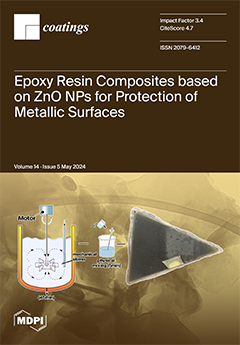In this study, laser cladding of CoCrFeNiMnTi
x (
x is the proportion of the mass of a material,
x = 0.0, 0.2, 0.4, 0.6, 0.8) high-entropy alloy (HEA) composite powder coating on 45 steel substrate was studied by using the method of
[...] Read more.
In this study, laser cladding of CoCrFeNiMnTi
x (
x is the proportion of the mass of a material,
x = 0.0, 0.2, 0.4, 0.6, 0.8) high-entropy alloy (HEA) composite powder coating on 45 steel substrate was studied by using the method of preplaced powder. The phase composition, morphology, microhardness, corrosion resistance and wear properties of CoCrFeNiMnTi
x high entropy alloy were analyzed by XRD, SEM, microhardness tester, electrochemical workstation and reciprocating friction wear tester, respectively. The influences of Ti concentration on structure and properties of CoCrFeNiMn HEA laser cladding coating were discussed. The macromorphology of CoCrFeNiMnTi
x HEA coating layer becomes worse with the increase in Ti quantity. The coating layer is a face-centered cubic solid solution phase. The microstructure of the coating layer is dominated by dendrites and equiaxed crystals. The average microhardness of the coating layer grows with the increases in Ti content, and CoCrFeNiMnTi
0.8 can reach 823 HV. The friction coefficient of the cladding coating gradually reduces and the wear resistance adds as Ti content rises; the friction coefficients of CoCrFeNiMnTi
0.6 and CoCrFeNiMnTi
0.8 cladding coating are similar, at 0.835 and 0.828, respectively. Adhesive and abrasive wear are the two basic types of cladding coating wear. In 3.5 wt.% NaCl solution, the corrosion potential of cladding coating increases with increases in Ti content, the corrosion potential of CoCrFeNiMnTi
0.8 is about 244 mV higher than that of CoCrFeNiMnTi
0, and the density of corrosion current drops to 3.41 × 10
−6 A/cm
2 from 7.17 × 10
−5 A/cm
2.
Full article





